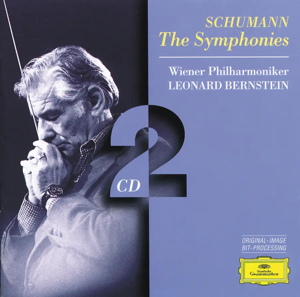
Robert Schumann (1810-1856)
Symphony No. 1 in B-flat, Op.38 ‘Spring’ (1841)
Symphony No. 2 in C, Op.61 (1846)
Symphony No. 3 in E-flat, Op.97 ‘Rhenish’ (1850)
Symphony No. 4 in D minor Op.120 (1841; rev. 1851)
Wiener Philharmoniker/Leonard Bernstein
rec. live, 1984-1985, Großer Saal, Musikverein, Vienna
Deutsche Grammophon 453 059-2 [2 CDs: 143]
When I first encountered these live recordings I found certain movements in them to be too slow and mannered; I now exercise the critic’s privilege of recanting and saying that despite the drive and energy of Bernstein’s earlier studio recording – all four symphonies taped in three weeks in 1960 – with the New York Philharmonic, I have come round to these live mid-80s performances as marginally superior – but I still have certain reservations.
That is not to say that the New York set is inferior; this is just a question of taste. As one might expect, however, given that the recordings are separated by a generation, there are differences, first in terms of sound: in the Manhattan Center, it is big, bright, brash, resonant and spotlit whereas in the Musikverein it is warmer, softer and more natural, as perhaps befits a recording reproducing what was heard live. Regarding tempi, there are fewer disparities than I recall: the last two movements of the Second, the Scherzo of the ‘Rhenish’ and the first movement of the Fourth are all are decidedly more leisurely and indulgent in Vienna, but only by a minute or so; otherwise timings are similar. In both recordings, Bernstein followed his lifelong attachment to Schumann’s original scoring, not employing any “orchestration lite” versions yet ensuring that the result is grand, sumptuous and heroic but never “claggy” or opaque.
It is also possible to take a “mix ‘n match” attitude to comparing the two sets in terms of artistic quality: I still prefer the opening of the New York ‘Rhenish’, which explodes with a joyous fervour audibly absent in Vienna. Likewise, in the majestic opening of the Fourth – one of my favourite introductions in the entire symphonic canon – I hear more inner tension in the earlier account. On the other hand, I love the splendour of the VPO’s brass in the opening of the First and prefer Bernstein’s more measured magniloquence there. The opening of the Second has a steady, measured tread prefiguring that of the Fourth – although of course its origins were contemporaneous with the First. Here I think, Bernstein finds more nobility in his later recording and the balance of the various instruments is better; in New York, the brass is too harshly overbearing and the Viennese woodwind is more mellifluous. In both recordings, the dancing lilt and momentum of the ensuing Allegro section are irresistible.
In short, neither set is flawless yet both are highly desirable: wonderful musicmaking of four of the greatest Romantic symphonies and collectors who are Bernstein devotees like me will want to own and compare both, playing either as the mood takes us. That is not to say that the complete symphonies by Karajan are redundant but as time has gone by I find myself less attached to sets I previously esteemed, such as those by Levine, who finds less nuance and sheer joy in these glorious works. When it comes to delivering Schumann, Lenny and Herbie rule!
Ralph Moore
Buying this recording via a link below generates revenue for MWI, which helps the site remain free.



















